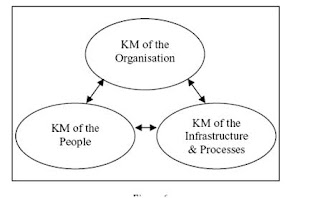Implementing knowledge management in organizations .
When speaking about implementing knowledge management in an organization I can clearly state that knowledge is one of the most important resource an organization has today . In today’s competing environment where the advances in I.T has considerably bridged the gap between competing companies ,the companies are using collective knowledge of the employees and also the feedbacks of the customers in order to produce competitive products to gain advantage .
The work carried out by various scholars have just provided more authority to the importance of knowledge in any organization. Likewise Zack(1999)stated “Business organisations are coming to view knowledge as their most valuable and strategic resource.” Nonaka(1998) also supports this , According to him in an economy the only certain thing is uncertainty and the one and only source of competitive advantage is knowledge So in today’s world the organization focus is more on the intellectual capital rather than tangible assets which was given more importance before. Now most managers feel that the critical source separating them from rivals is the knowledge asset and the intellectual capital of the employees , Liebowitz (2000).
When speaking about knowledge management in any organization We can say that firstly we need to draw a strategy so that it can be implemented in an organization . A knowledge management implementation strategy must be a function of the business strategy in order to accomplish the desired goals of the organization implementing the strategy .The KM strategy can thus be said as the resource of supplying knowledge to an organization in order to carry out its vision and also to achieve their goals .So the KM strategy must be aligned or you can say must fall within the business strategy of the organization which in turn will help to provide results that will ultimately give them a competitive advantage .
But it is not that KM strategies always satisfy the KM needs of the organizations because somewhere there lies a lack in cohesiveness across various approaches . Rubenstein, Montano et al,(2000) suggested the system thinking method which is basically viewing the complex processes in the organization and responding to the needs of the organization. Implementation of KM strategies have three categories .
Descriptive : describes KM, and also identifies the KM attributes that influences the success or failure of the approach taken .
Perspective : concerned with the type of KM procedures and not on how and when to carry out these procedures .
Hybrid : as the name suggests it is a mixture of both .
There is also a very important factor that affects the implementation of KM in organizations . It is that the employees and more importantly the top management officials are not very much committed with the implemented strategy.

Importance should also be given to the hardware and software which will be the medium for sharing and disseminate knowledge throughout the organization.
By following these guidelines we can implement KM in an organization effectively to obtain competitive advantage.
References:
1: ZACK, M.H. 1999a. Developing a Knowledge strategy. California Management Review, vol. 41, no. 3, 125-146.
2: NONAKA, I. 1998. The Knowledge-Creating Company. In Harvard Business Review on Knowledge Management. Harvard Business School Publishing, Boston.
3: LIEBOWITZ, J. 2000. Building Organizational Intelligence: A Knowledge Management Primer. CRC Press, Boca Raton.
4: RUBENSTEIN-MONTANO, R., LIEBOWITZ, J., BUCHWALTER, J., AND MCGRAW, D. 2000. A Systems Thinking Framework for Knowledge .
5 : Sunassee & Sewry, 2003 An Investigation of Knowledge Management Implementation Startegy proceedings of SAICSIT 24-36

Hamza,
ReplyDeleteGood to see you posting. You should do more!! that way it will make you become even more better but it must be quality and applicable not just anything! I am impressed that you have read more material and also improved the references too.
I like what you state -"advances of IT" but this has not fully yet bridged the gap. But also where Zack (1999) position on knowledge - does he determine how? I want you to critique
I want to see you give me example of organisation to show that I can understand your position after the literature reading! Your conclusion towards the end is just one sentence?
More room for improvement!
good luck
\(-___-)/